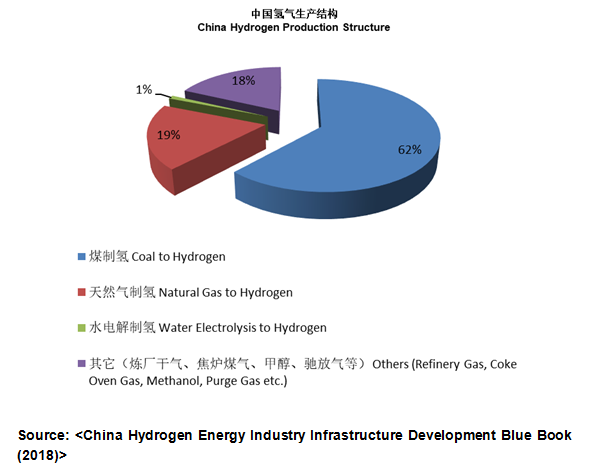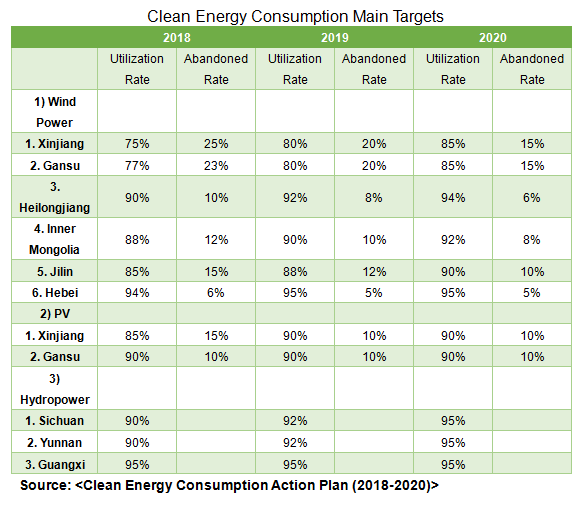Dec 2018, National Development and Reform Commission (NDRC) and National Energy Administration (NEA) joint issued <Clean Energy Consumption Action Plan (2018-2020)>, which points out that, exploring renewable energies surplus power converting into heat energy, cold energy and hydrogen energy and realizing renewable energy multipurpose nearby high-efficiency utilization.
Production methods of hydrogen mainly include fossil fuel to hydrogen, water electrolysis to hydrogen and industrial byproduct hydrogen etc. <China Hydrogen Energy Industry Infrastructure Development Blue Paper (2018)> data shows that, China hydrogen output in 2016 was about 21Mt, among, coal to hydrogen occupies about 62%, which is main hydrogen source; natural gas to hydrogen ranked second, occupies 19%.

ASIACHEM <China Hydrogen Energy and Fuel Cell Annual Report 2018> research indicates that, coal to hydrogen primary investment is high, however, as price of coal is relatively cheap, its hydrogen production cost competitiveness is quite strong; meanwhile, coal to hydrogen exists carbon emission problem. Natural gas to hydrogen process flow is simple, technology is matured, and device scale is flexible, however, it is limited by supply of natural gas, besides, carbon emission problem still exists. As for industrial byproduct hydrogen (propane dehydrogenation, ethane cracking, chlor-alkali chemical and coke oven gas), although these methods have large amount of byproduct hydrogen, most of them already have downstream applications.
ASIACHEM believes that, using renewable energies (including using large amount existed abandoned water, discarded light and abandoned wind, and biomass) electrolyze water to hydrogen deserve attentions.
China renewable energy resources are very abundant. With gradually development and perfection of new energy technology, China new energy new increased and accumulated installation capacities all rank No.1 in the world. Data shows that, up to end of 2017, China power generation installed capacities 1777.03MkW, among, hydropower, nuclear power, grid wind power and grid solar energy power generation accumulated occupy 37.8%, renewable energy installed capacity YOY increase 14%.
However, as power generation of new energy power is greatly influenced by season and weather, and not completely matched with stabled power demands, it is easy to lead large frequency fluctuation of power grid. In order to meet requirement of user side load, and reduce or avoid frequency fluctuation of power grid, there often causes abandoned wind, discarded light and abandoned water phenomenon and leads to very low new energy utilization rate. Information shows that, in 2017, China abandoned wind, discarded light and abandoned water volume reached 41.9BkWh, 7.3BkWh and 51.5BkWh, respectively; among, abandoned wind and discarded light rate reached 12% and 6%, respectively. In terms of provinces, abandoned wind rate of Gansu reached 33% and discarded light rate of Xinjiang reached 21.6%.
Dec 2018, NDRC and NEA joint released <Clean Energy Consumption Action Plan (2018-2020)>, which points out that, ensure China average wind power utilization rate reaching international advanced level (strives to reach about 95%), abandoned wind rate controlling at a reasonable level (strives to control at about 5%); PV power generation utilization rate is higher than 95% and discarded light rate is lower than 5%. China hydropower utilization rate is higher than 95%. China nuclear power realizes safety and guaranteed consumption.
At the same time, <Action Plan> points out, exploring renewable energies surplus power converting into heat energy, cold energy and hydrogen energy and realizing renewable energy multipurpose nearby high-efficiency utilization.

ASIACHEM believes that, using wind power and PV etc. fluctuating power and surplus hydropower to hydrogen energy can converts power which cannot storage into hydrogen which can storage, and application, is one of the technical options of renewable energy storage, which not only is benefit for stabled production of power stations, increasing economic returns, lengthening lives of power generation device and reducing energy consumption, but also can provide rising hydrogen energy applications with ‘zero carbon’ hydrogen sources. In the future, proportion of China renewable energy electrolyzes water to hydrogen will further increase.